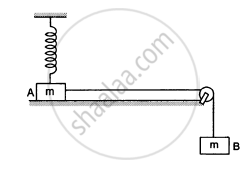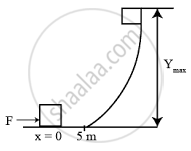Advertisements
Advertisements
प्रश्न
A mass of 5 kg is moving along a circular path of radius 1 m. If the mass moves with 300 revolutions per minute, its kinetic energy would be ______.
पर्याय
250 π2
100 π2
5 π2
0
उत्तर
A mass of 5 kg is moving along a circular path of radius 1 m. If the mass moves with 300 revolutions per minute, its kinetic energy would be `underline(250 π^2)`.
Explanation:
Given, mass = m = 5 kg
Radius = 1 m = R
Revolution per minute ω = 300 rev/min
= (300 × 2π) rad/min
= (300 × 2 × 3.14) rad/60 s
= `(300 xx 2 xx 3.14)/60` rad/s
= 10 × rad/s
⇒ Linear speed = v = ωR
= `((300 xx 2π)/60) (1m)`
= 10π m/s
KE = `1/2 mv^2`
= `1/2 xx 5 xx (10π)^2`
= `100π^2 xx 5 xx 1/2`
= 250 π2 J
APPEARS IN
संबंधित प्रश्न
A body is initially at rest. It undergoes one-dimensional motion with constant acceleration. The power delivered to it at time t is proportional to ______.
A person trying to lose weight (dieter) lifts a 10 kg mass, one thousand times, to a height of 0.5 m each time. Assume that the potential energy lost each time she lowers the mass is dissipated.
- How much work does she do against the gravitational force?
- Fat supplies 3.8 x 107J of energy per kilogram which is converted to mechanical energy with a 20% efficiency rate. How much fat will the dieter use up?
Figure shows a particle sliding on a frictionless track which terminates in a straight horizontal section. If the particle starts slipping from point A, how far away from the track will the particle hit the ground?

A small heavy block is attached to the lower end of a light rod of length l which can be rotated about its clamped upper end. What minimum horizontal velocity should the block be given so that it moves in a complete vertical circle?

In the following figure shows two blocks A and B, each of mass of 320 g connected by a light string passing over a smooth light pulley. The horizontal surface on which the block Acan slide is smooth. Block A is attached to a spring of spring constant 40 N/m whose other end is fixed to a support 40 cm above the horizontal surface. Initially, the spring is vertical and unstretched when the system is released to move. Find the velocity of the block A at the instant it breaks off the surface below it. Take g = 10 m/s2.

A body is falling freely under the action of gravity alone in vacuum. Which of the following quantities remain constant during the fall?
Why is electrical power required at all when the elevator is descending? Why should there be a limit on the number of passengers in this case?
A baloon filled with helium rises against gravity increasing its potential energy. The speed of the baloon also increases as it rises. How do you reconcile this with the law of conservation of mechanical energy? You can neglect viscous drag of air and assume that density of air is constant.
A single conservative force acts on a body of mass 1 kg that moves along the x-axis. The potential energy U(x) is given by U (x) = 20 + (x - 2)2, where x is in meters. At x = 5.0 m the particle has a kinetic energy of 20 J, then the maximum kinetic energy of body is ______ J.
A force shown in the F-x graph is applied to a 5 kg cart, which then coasts up a ramp as shown. The maximum height, ymax is ______ m, at which the cart can reach.
(g = 10 m/s2)


